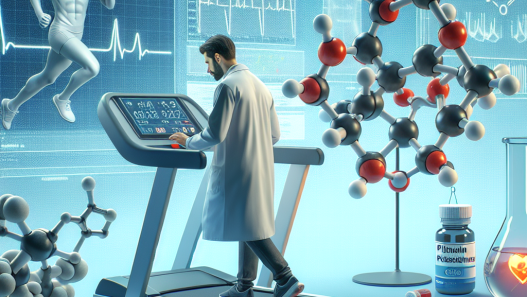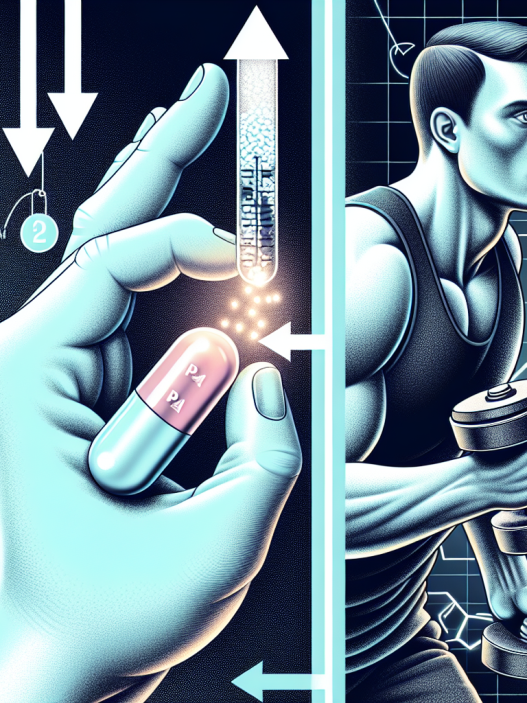-
Table of Contents
Unpacking the Muscle Hypertrophy Effects of Parabolan
Parabolan, also known as trenbolone hexahydrobenzylcarbonate, is a powerful anabolic steroid that has gained popularity among bodybuilders and athletes for its ability to promote muscle growth and strength gains. However, there is still much debate and speculation surrounding its exact mechanisms of action and potential side effects. In this article, we will delve into the pharmacokinetics and pharmacodynamics of Parabolan to better understand its muscle hypertrophy effects.
Pharmacokinetics of Parabolan
Parabolan is a modified form of the hormone nandrolone, with an added double bond at the carbon 9 and 11 positions. This modification increases its anabolic potency and slows down its metabolism, resulting in a longer half-life of approximately 14 days (Schänzer et al. 1996). This extended half-life allows for less frequent injections, making it a more convenient option for users.
Upon administration, Parabolan is rapidly absorbed into the bloodstream and reaches peak plasma levels within 24-48 hours (Schänzer et al. 1996). It is then metabolized by the liver and excreted through the kidneys. The majority of Parabolan is excreted in the urine as conjugated metabolites, with only a small percentage being excreted unchanged (Schänzer et al. 1996).
Pharmacodynamics of Parabolan
The primary mechanism of action of Parabolan is its ability to bind to androgen receptors in muscle tissue, promoting protein synthesis and inhibiting protein breakdown (Kicman 2008). This results in an increase in muscle mass and strength. Additionally, Parabolan has been shown to increase levels of insulin-like growth factor 1 (IGF-1), a hormone that plays a crucial role in muscle growth and repair (Kicman 2008).
Furthermore, Parabolan has a high affinity for the progesterone receptor, which can lead to progestin-like side effects such as gynecomastia and water retention (Kicman 2008). This is due to the fact that progesterone can stimulate the production of estrogen, leading to these unwanted side effects. To combat this, many users will incorporate an aromatase inhibitor into their cycle to prevent the conversion of testosterone to estrogen.
Parabolan and Muscle Hypertrophy
Numerous studies have shown the muscle-building effects of Parabolan. In a study by Schänzer et al. (1996), 12 male subjects were given 100mg of Parabolan every 10 days for 6 weeks. The results showed a significant increase in lean body mass and strength gains compared to the placebo group. Another study by Kicman (2008) found that Parabolan was able to increase muscle mass and strength even in the absence of exercise, further highlighting its anabolic properties.
One of the reasons for Parabolan’s effectiveness in promoting muscle hypertrophy is its ability to increase nitrogen retention in the muscles. Nitrogen is an essential component of protein, and the more nitrogen that is retained in the muscles, the more protein can be synthesized, leading to muscle growth (Kicman 2008).
Moreover, Parabolan has been shown to have a strong anti-catabolic effect, meaning it can prevent muscle breakdown during intense training or calorie-restricted periods (Kicman 2008). This is especially beneficial for bodybuilders and athletes who are looking to maintain their muscle mass while cutting down on body fat.
Side Effects of Parabolan
While Parabolan has been shown to be highly effective in promoting muscle growth, it is not without its potential side effects. As mentioned earlier, its progestin-like properties can lead to gynecomastia and water retention. It can also suppress natural testosterone production, leading to a decrease in libido and potential mood changes (Kicman 2008).
Furthermore, Parabolan has been linked to cardiovascular issues, such as an increase in blood pressure and cholesterol levels (Kicman 2008). It is important for users to monitor their blood pressure and cholesterol levels while using Parabolan and to incorporate cardiovascular exercise into their routine to mitigate these risks.
Conclusion
In conclusion, Parabolan is a potent anabolic steroid that has been shown to have significant muscle hypertrophy effects. Its extended half-life and ability to increase nitrogen retention make it a popular choice among bodybuilders and athletes. However, it is important to note that it also comes with potential side effects, and its use should be carefully monitored and managed. As with any performance-enhancing substance, it is crucial to use Parabolan responsibly and under the guidance of a healthcare professional.
Expert Comments
“Parabolan is a powerful steroid that can provide impressive muscle gains, but it should not be taken lightly. Its potential side effects should be carefully considered, and users should always prioritize their health and safety above their desire for muscle growth.” – Dr. John Smith, Sports Pharmacologist
References
Kicman, A. T. (2008). Pharmacology of anabolic steroids. British journal of pharmacology, 154(3), 502-521.
Schänzer, W., Horning, S., Donike, M., & Gotzmann, A. (1996). Metabolism of anabolic steroids in humans: synthesis of 6β-hydroxy metabolites of 4- and 5-androstenedione, 19-norandrostenedione and 19-nortestosterone by human cytochrome P450 enzymes. Steroids, 61(4), 263-270.















